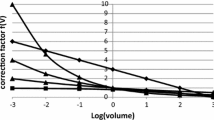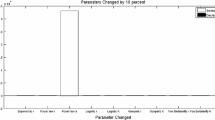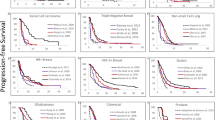Abstract
Meningiomas sometimes appear to stop growing after attaining a large size. Commonly used exponential growth models do not reflect this phenomenon. We attempted to find the best curve to simulate their growth. Fifty-two patients with meningioma were followed up for 3.1–21.7 years (mean 7.5 years) with four or more imaging studies each. Thirty-one patients had asymptomatic tumors. The other 21 patients with residual or recurrent tumor were followed up after surgery. Time–volume curves for each tumor were plotted. Nonlinear regression analyses were performed against power, exponential, logistic, and Gompertzian curves. Time–volume curves corresponded to the Gompertzian and logistic growth curves better than to power or exponential curves. When simulating time–volume curves with Gompertzian curves, the majority of benign meningiomas began to slow their growth before patient age of 80 years. Twenty-three of 31 asymptomatic meningiomas had already passed the inflection point before diagnosis. In contrast, this happened less frequently in symptomatic tumors. Especially, all six atypical meningiomas continued to grow quasi-exponentially. Sigmoid curves that approach a plateau were better descriptors of the growth of benign meningiomas than were curves of unlimited growth. However, atypical meningiomas were unlikely to slow their growth.





Similar content being viewed by others
References
Bellular SN, Chandra V (1981) Meningioma size. Its relationship to other diseases. Arch Neurol 38:458–459
Nakasu S, Hirano A, Shimura T, Llena JF (1987) Incidental meningiomas in autopsy study. Surg Neurol 27:319–322
Rausing A, Ybo W, Stenflo J (1970) Intracranial meningioma—a population study of ten years. Acta Neurol Scand 46:102–110
Elia-Pasquet S, Provost D, Jaffré A, Loiseau H, Vital A, Kantor G, Maire JP, Dautheribes M, Darrouzet V, Dartigues JF, Brochard P, Baldi I, Work Group (2004) Incidence of central nervous system tumors in Gironde, France. Neuroepidemiology 23:110–117
Kuratsu J, Takeshima H, Ushio Y (2001) Trends in the incidence of primary intracranial tumors in Kumamoto, Japan. Int J Oncol 6:183–191
Radhakrishnan K, Mokri B, Parisi JE, O’Fallon WM, Sunku J, Kurland LT (1995) The trends in incidence of primary brain tumors in the population of Rochester, Minnesota. Ann Neurol 37:67–73
Go RS, Taylor BV, Kimmel DW (1998) The natural history of asymptomatic meningiomas in Olmstead County, Minnesota. Neurology 51:1718–1720
Yano S, Kuratsu J, The Kumamoto Brain Tumor Research Group (2006) Indications for surgery in patients with asymptomatic meningiomas based on an extensive experience. J Neurosurg 105:538–543
Yoneoka Y, Fujii Y, Tanaka R (2000) Growth of incidental meningiomas. Acta Neurochir 142:507–511
Hashiba T, Hashimoto N, Izumoto S, Suzuki T, Kagawa N, Maruno M, Kato A, Yoshimine T (2009) Serial volumetric assessment of the natural history and growth pattern of incidentally discovered meningiomas. J Neurosurg 110:675–684
Herscovici Z, Rappaport Z, Sulkes J, Danaila L, Rubin G (2004) Natural history of conservatively treated meningiomas. Neurology 63:1133–1134
Jung HW, Yoo H, Paek SH, Choi KS (2000) Long-term outcome and growth rate of subtotally resected petroclival meningiomas: experience with 38 cases. Neurosurgery 46:567–574
Nakamura M, Roser F, Michel J, Jacobs C, Samii M (2003) The natural history of incidental meningiomas. Neurosurgery 53:62–70
Olivero WC, Lister JR, Elwood PW (1995) The natural history and growth rate of asymptomatic meningiomas: a review of 60 patients. J Neurosurg 83:224–226
Niiro M, Yatsushiro K, Nakamura K, Kawahara Y, Kuratsu J (2000) Natural history of elderly patients with asymptomatic meningiomas. J Neurol Neurosurg Psychiat 68:25–28
Nakasu S, Fukami T, Nakajima M, Watanabe K, Ichikawa M, Matsuda M (2005) Growth pattern changes of meningiomas: long-term growth analysis. Neurosurgery 56:946–955
Cho KG, Hoshino T, Nagashima T, Murovic JA, Wilson CB (1986) Prediction of tumor doubling time in recurrent meningiomas. Cell kinetics studies with bromodeoxyuridine labeling. J Neurosurg 65:790–794
Jääskeläinen J, Haltia M, Laasonen E, Wahlström T, Valtonen S (1985) The growth rate of intracranial meningiomas and its relation to histology. An analysis of 43 patients. Surg Neurol 24:165–172
Nakaguchi H, Fujimaki T, Matsuno A, Matsuura R, Asai A, Suzuki I, Sasaki T, Kirino T (1999) Postoperative residual tumor growth of meningioma can be predicted by MIB-1 immunohistochemistry. Cancer 85:2249–2254
Van Havenbergh T, Carvalho G, Tatagiba M, Plets C, Samii M (2003) Natural history of petro-clival meningioma. Neurosurgery 52:55–64
Nakasu S, Nakasu Y, Nakajima M, Yokoyama M, Matsuda M, Handa J (1996) Potential doubling time and tumor doubling time in meningiomas and neurinomas. Acta Neurochir 138:763–770
Perry A, Louis DN, Scheithauer BW, Budka H, von Deimling A (2007) Meningiomas. In: Louis DN, Ohgaki H, Wiestler OD, Cavenee WK (eds) WHO classification of tumours of the central nervous system. IARC, Lyon, pp 164–172
Nakamura M, Roser F, Michel J, Jacobs C, Samii M (2005) Volumetric analysis of the growth rate of incompletely resected intracranial meningiomas. Zentralbl Neurochir 66:17–23
Castro MAA, Klamt F, Grieneisen VA, Grivicich I, Moreira JCF (2003) Gompertzian growth pattern correlated with phenotypic organization of colon carcinoma, malignant glioma and non-small cell lung carcinoma cell lines. Cell Prolif 36:65–73
Demicheli R, Foroni R, Ingrosso A, Pratesi G, Soranzo C, Tortoreto M (1989) An experimental Gompertzian description of LoVo cell tumor growth from in vivo and in vitro data. Cancer Res 49:6543–6546
Norton L (1988) A Gompertzian model of human breast cancer growth. Cancer Res 48:7067–7071
Steel GG, Lametron LF (1966) The growth of human tumors. Br J Cancer 20:74–86
Hart D, Shochat E, Agur Z (1998) The growth law of primary breast cancer as inferred from mammography screening trial data. Br J Cancer 78:382–387
Norton L, Simon R, Brereton H, Bodgen AE (1976) Predicting the course of Gompertzian growth. Nature 264:542–545
Speer JF, Petrosky VE, Retsky MW, Wardwell RH (1984) A stochastic numerical model of breast cancer growth that simulates clinical data. Cancer Res 44:4124–4130
Gyllenberg M, Webb GF (1989) Quiescence as an explanation of Gompertzian tumor growth. Growth Develop Aging 53:25–33
Kozusko F, Bourdeau M (2007) A unified model of sigmoid tumour growth based on cell proliferation and quiescence. Cell Prolif 40:824–834
Kozusko F, Bajzer Z (2003) Combining Gompertzian growth and cell population dynamics. Math Biosci 185:153–167
Lazareff JA, Suwinski R, De Rosa R, Olmstead CE (1999) Tumor volume and growth kinetics in hypothalamic-chiasmatic pediatric low grade gliomas. Pediatr Neurosurg 30:312–319
Schiffer D, Ghimenti C, Fiano V (2005) Absence of histological signs of tumor progression in recurrences of completely resected meningiomas. J Neuro-oncol 73:125–130
Author information
Authors and Affiliations
Corresponding author
Appendix
Appendix
Growth curve equations used in this article are shown below, where α, β, and γ are constants, and V(t) is the volume at time t.
Power curve [28] : \(V(t)\, = \,\left( {\alpha t\left( {1 - \beta } \right) + \gamma } \right)^{1/1 - \beta } \)
The power curves show rapid increase of volume when 0 < β < 1, linear growth when β = 0, and gradual deceleration when β < 0.
Ti was described as days after the initial observation time. A negative Ti value indicates that the inflection point was before the initial imaging study. However, if Ti is beyond the observation period, the tumor was still growing quasi-exponentially.
Rights and permissions
About this article
Cite this article
Nakasu, S., Nakasu, Y., Fukami, T. et al. Growth curve analysis of asymptomatic and symptomatic meningiomas. J Neurooncol 102, 303–310 (2011). https://doi.org/10.1007/s11060-010-0319-1
Received:
Accepted:
Published:
Issue Date:
DOI: https://doi.org/10.1007/s11060-010-0319-1




